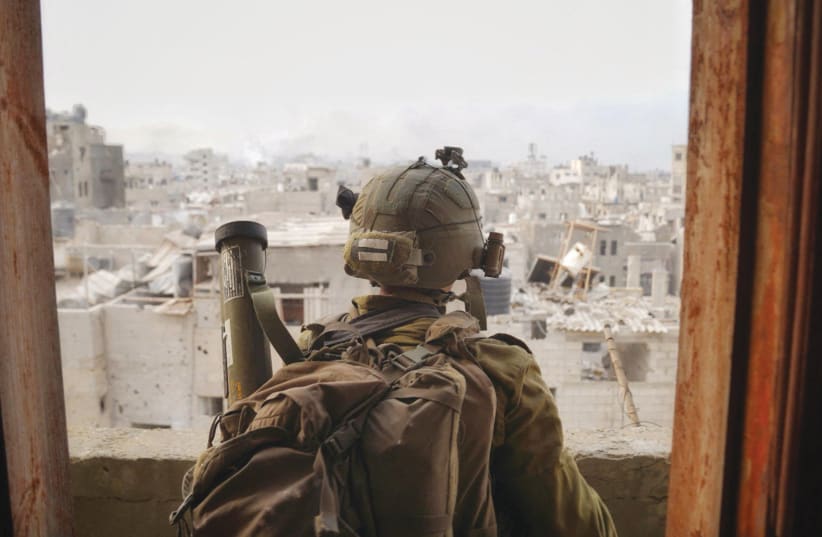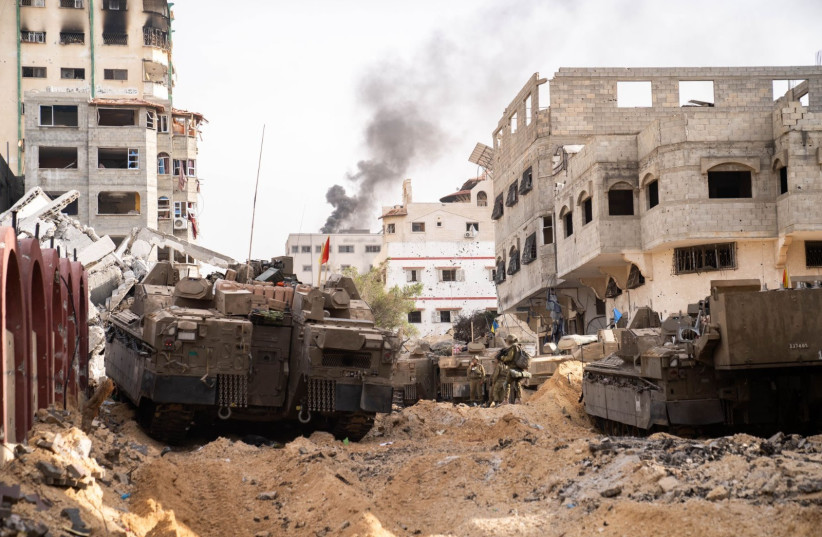The way we in Israel react to the massive Israeli bombing from the air, and demolition activities from the ground, which have left large sections of Gaza City in ruins, which resemble the sights of destruction all over Europe at the end of the Second World War, differs from person to person, on the basis of political affiliation, cultural background, and numerous other factors.
There are those who are delighted, and hope that the Gazans themselves will be at least partially banished for good from the region, while wishing that Jewish settlement in the Gaza Strip will now be renewed (even though the government seems to be opposed to this option).
Others, despite their shock and grief at the atrocities of October 7, feel at least some compassion for the innocent civilians, especially for the children of Gaza – the 4,000 who are reported to have been killed in the last 40 days – and all those who no longer have a home to returthn to, and who have no sort of future to look forward to.We do not really agree on whether there are “innocent civilians” in Gaza.
What we can agree on
Where most of us agree is that, given the historical record of how past limited military skirmishes and operations between the IDF and the terrorist organizations in the Strip ended inconclusively, and given the horrific atrocities committed by the Hamas terrorists on October 7, the inescapable conclusion (from the Israeli perspective) is that the Hamas must cease to exist as a viable military and governing entity.
There also seems to be concurrence among most of the political and social groups in Israel that the destruction of Hamas cannot be achieved without massive physical destruction in the Strip, due the manner in which Hamas immersed itself within the Gazan civilian population, using hospitals, schools, mosques, and other public structures as places of hiding and refuge for its leaders and fighting forces, and for caches of munitions and other essential commodities required by the organization to carry out its relentless war against Israel.
Even though the massive movement of around a million Palestinian civilians from the north to the south of the Strip at Israel’s prodding has turned into a massive humanitarian problem, it cannot be denied that for this population to have stayed put in the north would have constituted a much more deadly humanitarian catastrophe. Yet, it is a lose-lose situation for them.
Investing in terrorisim
Why this massive movement of people has been necessary is that, since it gained power in the Strip in 2007, Hamas, it is estimated, has invested over $1 billion (some believe the sum reaches several billion) in a system of deep tunnels, colloquially referred to as the Gaza metro. The metro is made up of at least 500 km. of deeply dug tunnels, used to transport persons and goods; to store rockets and ammunition caches; and house Hamas command and control centers, invisible to IDF aircraft and surveillance drones.
The entrance shafts of the tunnels exist all over, but the most important ones exist in such locations as the Shifa Hospital, which inter alia provide the tunnels with electricity for lighting and ventilation purposes, and prevent the free entrance to anyone not authorized.
Since the IDF suspects that many of the tunnels have been booby-trapped (which has already been sadly proven to be true), the plan is to destroy the tunnels from the outside, with special bunker buster munitions. This is the main reason for razing to the ground whole areas under which the tunnels are known to exist, and why the population must move.
Recalling history
AGAINST THIS background I recalled the years 1987-1990 – from just before and during the First Intifada, when Israel was still the direct ruler of the Strip, whose population numbered only 650,000 persons, compared to today’s 2.1 million – when I used to visit a close friend in the city of Gaza: the renown Palestinian psychiatrist, and peace activist Dr. Eyad el-Sarraj, in whose company I roamed about the city and met dozens of Gazans of all walks of life.
Sarraj, who died in 2013, believed in the importance of dialogue between Palestinians and Israelis. Much of his professional work as a psychiatrist had to do with the children of Gaza, whom he diagnosed as suffering from numerous psychological problems and difficulties, resulting from the hopeless environment and situation they were growing up in.
Both this reality and the fact that, already in the late 1980s, many of the children in Gaza were subjected to brainwashing by extremist Muslim organizations (Hamas, which was established only in 1987, and at first enjoyed our tacit support, was not yet one of them), might explain the monstrous conduct of the Hamas terrorists of October 2023, though presumably they were all born after the First Intifada.
At the time I wrote several articles about my experiences and the conversations I held in Gaza, most of which were published in the now defunct Labor daily Davar. Many of the locations now being mentioned in the news, including Shifa Hospital, were places I had visited in those days.
I remember one conversation with a young Gazan businessman while we were watching the Eurovision Song Contest, in which Israel participated (not exactly an activity one would associate with Gaza). He wondered out loud whether an independent Palestinian state would ever be a participant in the song contest, and we went on to muse over the prospects for a Palestinian state or, short of a Palestinian state, Gaza turning into a Middle Eastern Singapore.
These days Gaza is as far as can be from turning into a Singapore, but one cannot help wondering whether, if over $1b. had been invested in the economy and not in a system of underground tunnels constructed with the purpose of eventually destroying the State of Israel – tunnels that, it is to be hoped, will soon turn into little more than rubble – a different reality might have been created.
Was it inevitable that the main political force to develop in the Strip – which has also gained immense popularity among the Palestinian population in the West Bank – is an ISIS-like fanatic religious organization, which apparently really believed that it could bring about Israel’s collapse by means of the infiltration of some 3,000, armed (and apparently also drugged) professional terrorists? But perhaps Hamas believed that its move would cause other Muslim forces – including Iran – to join the fighting.
What will be Gaza's future?
What does the future of the Strip hold in store, after this insane war, which, it is to be hoped, will end with the demise of Hamas as a military and political force? What are the chances that somehow, out of all the destruction and carnage, a more moderate, constructive, and peaceful Palestinian leadership, and a more constructive and peace-searching Israeli government, will emerge?
Under the circumstances, is there any chance for the development of a true dialogue between Israelis and Palestinians, or for that matter, is there any chance for the development of a true dialogue within Israeli society, with all its schisms and divides?
I was much more optimistic that all this was possible back in the years 1987-1990, and during the decade that followed.
The writer worked in the Knesset for many years as a researcher and has published extensively both journalistic and academic articles on current affairs and Israeli politics. Her most recent book, Israel’s Knesset Members – A Comparative Study of an Undefined Job, was published by Routledge last year.

